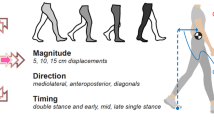Abstract
This paper proposes a method for enhancing the robustness of the central pattern generator (CPG)-based three-dimensional (3D) neuromusculoskeletal walking controller. The CPG has been successfully applied to walking controllers and controllers for walking robots. However, the robustness of walking motion with the CPG-based controller is not sufficient, especially when subjected to external forces or environmental variations. To achieve a realistic and stable walking motion of the controller, we propose the use of an attracting controller in parallel with the CPG-based controller. The robustness of the proposed controller is confirmed through simulation results.
Similar content being viewed by others
References
Austin GP, Garrett GE, Bohannon RW (1999) Kinematic analysis of obstacle clearance during locomotion. Gait Posture 10:109–120
Chandler RF, Clauser CE, McConville JT, Reynolds HM, Young JW (1975) Investigation of inertial properties of the human body, AMRL-TR-74-137. Wright-Patterson Air Force Base, OH
Chao EY, Laughman RK, Schneider E, Stauffer RN (1983) Normative data of knee joint motion and ground reaction forces in adult level walking. J Biomech 49(3): 219–233
Eng JJ, Winter DA (1995) Kinetic analysis of the lower limbs during walking; what information can be gained from a three-dimensional model?. J Biomech 28(6): 753–758
Eng JJ, Winter DA, Patla AE (1994) Strategies for recovery from a trip in early and late swing during human walking. Exp Brain Res 102: 339–349
Grillner S (1975) Locomotion in vertebrates—central mechanisms and reflex interaction. Physiol Rev 55: 247–304
Grillner S, Rossignol M (1978) On the initiation of the swing phase locomotion in chronic spinal cats. Brain Res 146: 269–277
Grillner S, Wallen P (1982) On peripheral control mechanisms acting on the central pattern generators for swimming in the dogfish. J Exp Biol 98: 1–22
Hase K, Yamazaki N (2002) Computer simulation study of human locomotion with a three-dimensional entire-body neuro-musculo-skeletal model. JSME Int J 45(4): 1040–1050
Kadaba MP, Ramakrishnan HK, Wootten ME (1990) Measurement of Lower Extremity Kinematics During Level Walking. J Orthop Res 8(3): 383–392
Kamada S, Kim S, Obinata G (2009) Task based design method for simpler mechanisms. In: International conference on mechatronics and information technology, pp 365–366, Gwangju, Korea
Matsuoka K (1985) Sustained oscillations generated by mutually inhibiting neurons with adaptation. Biol Cybern 52: 367–376
Matsuoka K (1987) Mechanisms of frequency and pattern control in the neural rhythm generators. Biol Cybern 56: 345–353
Menz HB, Lord SR, Fitzpatrick RC (2003) Acceleration patterns of the head and pelvis when walking on level and irregular surfaces. Gait Posture 18: 35–46
Milner-Brown HS, Stein RB, Yemm R (1976) Contractile properties of human motor units during voluntary isometric contractions. J Physiol 228: 285–306
Misiaszek JE, Stephens MJ, Yang JF, Pearson KG (2000) Early corrective reactions of the leg to perturbations at the torso during walking in humans. Exp Brain Res 131: 511–523
Moe-Nilssen R (1998) A new method for evaluating motor control in gait under real-life environmental conditions. Clin Biomech 13: 320–335
Naito J, Obinata G, Nakayama A, Hase K (1007) Development of a wearable robot for assisting carpentry workers. Int J Adv Robot Syst 4(4): 431–436
Orlovsky G, Deliagina TG, Grillner S (1999) Neural control of locomotion: from mollusc to man. Oxford University Press, London
Penfield W, Jasper H (1954) Epilepsy and the functional anatomy of the human brain. Little Brown, Boston
Schillings AM, Van Wezel BMH, Mulder TH, Duysens J (2000) Muscular responses and movement strategies during stumbling over. J Neurophysiol 83: 2093–2102
Shik ML, Orlovsky GN (1976) Neurophysiology of locomotor automatism. Physiol Rev 56: 465–501
Taga G (1995) A model of the neuro-musculo-skeletal system for human locomotion. Biol Cybern 73: 97–111
Taga G (1998) A model of the neuro-musculo-skeletal system for anticipatory adjustments of human locomotion during obstacle avoidance. Biol Cybern 78: 9–17
Taga G, Yamaguchi Y, Shimizu H (1991) Self-organized control of bipedal locomotion by neural oscillators in unpredictable environment. Biol Cybern 63: 147–159
Thies SB, Richardson JK, Ashton-Miller JA (2005) A Effects of surface irregularity and lighting on step variability during gait: a study in healthy young and older women. Gait Posture 22: 26–31
Thies SB, Ashiton-Miller JA, Richardson JK (2007) What causes a crossover step when walking on uneven ground? A study in healthy young women. Gait Posture 26: 156–160
Winter DA, Yack HJ (1987) EMG profiles during normal human walking: stride to stride and inter-subject variability. Electroencephalogr Clin Neurophysiol 67: 402–411
Yack HJ, Berger RC (1993) Dynamic stability in the elderly: identifying a possible measure. J Gerontol 48: 225–230
Yamasaki T, Nomura T, Sato S (2003) Possible functional roles of phase resetting during walking. Biol Cybern 88: 468–496
Zitsiorsky V, Seluyanov V (1983) The mass and inertia characteristics of the main segments of the human body. In: Matsui H, Kobayashi K (eds) Biomechanics VIII-B. Human Kinetics, Champaign, pp 1152–1159
Author information
Authors and Affiliations
Corresponding author
Electronic Supplementary Material
The Below is the Electronic Supplementary Material.
Rights and permissions
About this article
Cite this article
Kim, Y., Tagawa, Y., Obinata, G. et al. Robust control of CPG-based 3D neuromusculoskeletal walking model. Biol Cybern 105, 269–282 (2011). https://doi.org/10.1007/s00422-011-0464-4
Received:
Accepted:
Published:
Issue Date:
DOI: https://doi.org/10.1007/s00422-011-0464-4




